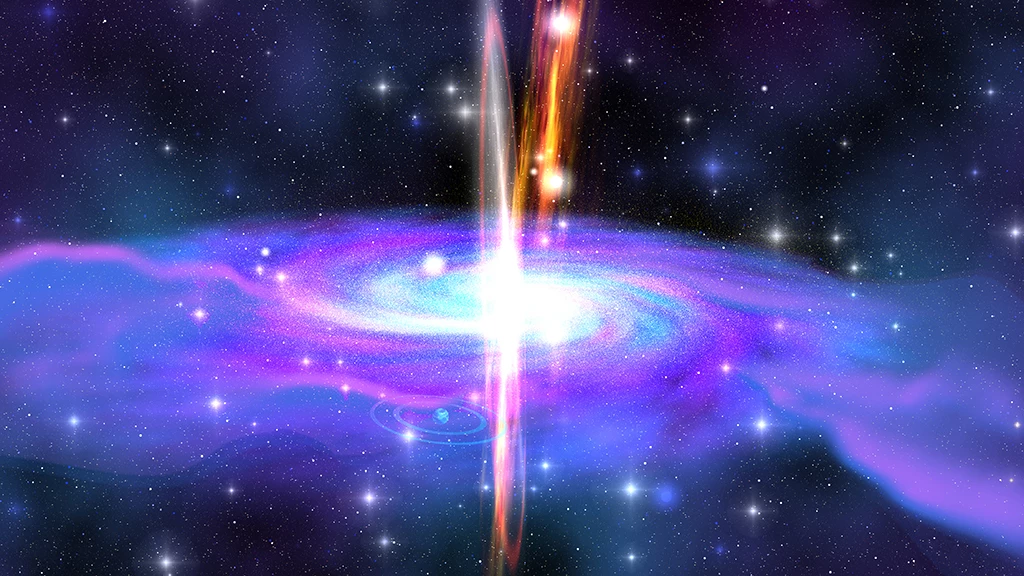A recent study of gamma-ray bursts by Professor Robert Nemiroff and his colleagues at Michigan Technological University provides the first strong evidence concerning the small-scale smoothness of spacetime. Oddly, this examination of the very small is accomplished by measuring a handful of gamma-rays after they traveled over ten billion light years.
Spacetime is that four-dimensional arena (three of length (x,y,z) and one of time(t)) in which we play out our lives. Relativity tells us that spacetime is curved, and that curvature causes the force of gravity. A very thin rubber sheet is a pretty good two-dimensional analog to spacetime – if the sheet is flat, a ping-pong ball on the sheet will stay in place, while if the sheet is curved, the same ball will move.
On the Earth's surface, spacetime is quite flat, with only a small curvature associated with the Earth's gravity. Billion light-year stretches of the Universe also appear to be rather flat, with only small curvature appearing near galaxy clusters. However, something strange happens when you try to find out what spacetime looks like for very small lengths. That something strange is called quantum foam.
Quantum foam is a conceptual description of how spacetime may appear on the smallest length scales – far smaller than elementary particles. From quantum mechanics comes the idea of virtual particles, which are massive particles that can appear for a time short enough that the uncertainty principle prevents our seeing them. In relativity, however, mass (including virtual mass) curves spacetime. Accordingly, when a virtual particle appears, the curvature of spacetime changes.

More massive virtual particles are restricted to smaller volumes of spacetime, as they appear for a time that becomes smaller as the particles become more massive, and even virtual particles can't travel faster than light. Eventually, as the mass of a virtual particle increases, it is located in a region small enough that it forms a tiny black hole. This occurs for a mass of about ten micrograms.
At this point, spacetime is filled with fluctuating regions of curvature that come and go very rapidly. On our scale, all this activity averages out to appear like a slightly curved sheet of paper. On the quantum scale (lengths of about one divided by a thousand quadrillion quadrillion centimeters, called the Planck length), spacetime (according to this picture) takes on a constantly changing geometry that has been compared to a foam. This is the quantum foam.
At present, our instruments can at best examine structures a hundred thousand trillion times larger than the quantum scale – a difference so vast that detecting the quantum foam has been thought to be impossible, or at least impossibly difficult. But what if the quantum foam has side effects that can be detected?
The speed of light is held to be a single, constant value regardless of the color of the light. (This isn't true in some quantum gravity theories, but that would take us too far afield.) But can distance between two points change depending on the color of light used to measure that distance? Here's an analogy. Let's say that you want to measure the radius of an old vinyl record. One approach is to take the phonograph needle and pull it across the surface of the record, keeping track of the distance the needle tip travels. The accompanying "brrrrrrrip" sound occurs because the needle tip is traveling up and down over the grooves of the record as well as radially toward the center of the record. The radius you measure will be the distance of going up and down the grooves, in addition to the horizontal radial distance.
Now perform the same measurement, but replace the needle with a ping-pong ball. This time the ping-pong ball is barely affected by the grooves because it is too blunt to get down into them. As a result, the distance measured this time is almost equal to the horizontal radius of the record – the "needle" radius of the record is quite a bit longer than the "ping-pong ball" radius.
The same idea should hold for measuring distance in spacetime. With a constant speed of light, the distance between two points can be found by measuring the time it takes light to pass between the points. A photon with a very short wavelength may notice the ripples in spacetime due to the quantum foam, while a photon with a long wavelength may see a shorter distance.
This is where the gamma-ray bursts come in. The photons on which this study is based were detected by the Fermi Gamma-Ray Space Telescope and selected for having arrived in a cluster of photons having a wide range of energies, all of which were emitted in a single gamma-ray burst.
One set of photons in particular, originating in a galaxy almost seven billion light-years distant, differed in their time of arrival by a mere 1.55 milliseconds. This limits the difference in distance between the photons (which ranged in energy from 1.58 to 24.7 GeV) to less than 500 kilometers, or about one part in a billion trillion. A similar limit was found in an earlier study of photons with energies between 30 and 200 keV.
As small as the difference in distance is, it can be compared with very preliminary quantum gravity calculations to determine on what size scale the fabric of space may be pixelated. According to the Michigan Tech group, spacetime is free of major irregularities on size scales below about 525 Planck lengths in size. Spacetime appears unexpectedly smooth on the smallest meaningful distances, taking after foam rubber rather than beer foam.





